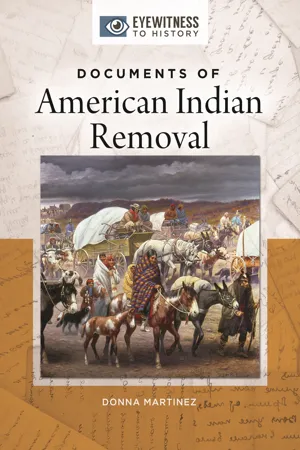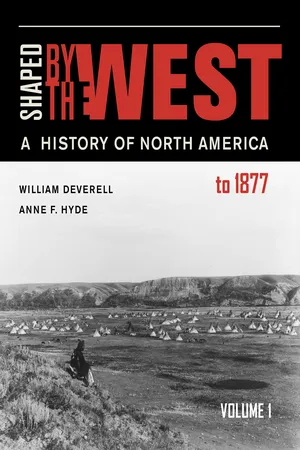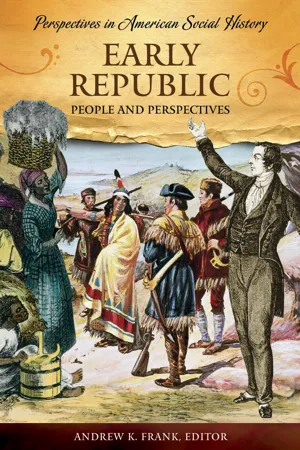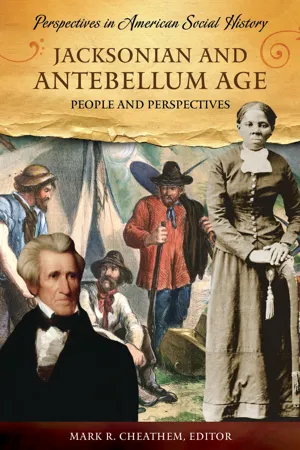History
Indian Removal Act
The Indian Removal Act was a law passed by the United States Congress in 1830, which authorized the removal of Native American tribes from their ancestral lands in the southeastern United States to territories west of the Mississippi River. This forced relocation, known as the Trail of Tears, resulted in the displacement and suffering of thousands of Native Americans, leading to a significant loss of life and cultural heritage.
Written by Perlego with AI-assistance
11 Key excerpts on "Indian Removal Act"
- eBook - ePub
All Things Dickinson
An Encyclopedia of Emily Dickinson's World [2 volumes]
- Wendy Martin Ph.D.(Author)
- 2014(Publication Date)
- Greenwood(Publisher)
In addressing the 21st Congress, President Andrew Jackson (1767–1845) announced that, after 30 years, two tribes had accepted the U.S. government’s call for their removal, which would serve as an example for other tribes: “It will place a dense and civilized population in large tracts of country now occupied by a few savage hunters” (“President’s Message,” 1830, 4). The Indian Removal Act of 1830 called for “an exchange of lands with the Indians” living in any U.S. territories and their subsequent removal west of the Mississippi River. The act allowed the president to give Indians certain territories that the United States would “forever secure and guaranty to them, and their heirs and successors.” The act also allowed the president to authorize payment to the Indians for their lands, to exercise authority over the tribes, and to protect the Indians “against all interruption and disturbance . . . from any other person or persons whatever.”In 1835, a small group of Cherokee signed the Treaty of Echota, which agreed to a migration from the current Cherokee land. Cherokee Chief John Ross (1790–1866) protested the treaty; he claimed that those who signed it had no authority to do so. In a letter to the Senate and the House, Ross wrote, “[W]e are despoiled of our possessions . . . . We are stripped of every attribute of freedom and eligibility for legal self-defence . . . . We are denationalized; we are disfranchised” (1836). In 1838 and 1839, the Cherokee nation’s forced relocation under the Indian Removal Act came to be known as the Trail of Tears. After only 2,000 out of 18,000 Cherokee voluntarily migrated, U.S. troops aggressively enforced Jackson’s Act. About 4,000 Cherokee died en route.Native Americans travel through a snowstorm in a forced migration to land set aside by the Indian Removal Act of 1830. (North Wind Picture Archives)Yet, this matter was not simply resolved nor did the tribes quietly cede to the U.S. government’s laws. After the Civil War, the military’s main task “was to cope with the Indians, but other developments” impeded this (Wooster 1988, 13–14). Some whites were found with the tribes; one newspaper account recalled that “Not only are there white refuges with the northern tribes, but there are white men who once held good positions in civilized life, with the Comanches and the Apaches” (“Indians,” 1867, 3). Also, tribes did fight in myriad ways against U.S. forces, and were not simply passive in the face of their removal. The Cherokee nation went to the Supreme Court in order to retain their land and own governance. In The Cherokee Nation v. The State of Georgia - eBook - PDF
How the Indians Lost Their Land
Law and Power on the Frontier
- Stuart Banner, Stuart BANNER(Authors)
- 2009(Publication Date)
- Belknap Press(Publisher)
Y 6 Removal The word removal conventionally denotes a distinct era in the history of United States Indian policy, from the late 1820s through the early 1840s. As the story is usually told, during that period the federal government, at the urging of President Andrew Jackson, forced most of the remaining eastern Indians to migrate west of the Mississippi River. Between 1828 and 1838, more than eighty thousand Indians were removed from the east to the west. The enduring image of the period is the Trail of Tears —the U.S. Army’s internment and forced relocation of approximately sixteen thousand Cherokees in the fall and winter of 1838–1839, under circumstances so dire that four thousand are said to have died along the route between Georgia and what is now Oklahoma. 1 Removal has accordingly taken on sinister connotations, sinister be-cause of the mismatch between the word’s surface blandness and the cruelty of some of the events it was used to describe. After a century in which Orwellian terms like ethnic cleansing and the final solution became commonplace, the very word removal sounds chilling today. It evokes the idea of a newly aggressive federal government opening a new chap-ter in its Indian relations by forcibly pushing American Indians west of the Mississippi in order to seize their land and parcel it out to white set-tlers. In light of the story thus far, however, removal looks much more like a continuation of earlier Indian land policy than a departure from it. Re-moval, just like the acquisition of Indian land for the previous two hun-dred years, was structured as a series of voluntary transactions. The fed-eral government went to considerable trouble to obtain the signatures of Indians on treaties in which the tribes ostensibly consented to be re-moved. - eBook - PDF
Surviving Genocide
Native Nations and the United States from the American Revolution to Bleeding Kansas
- Jeffrey Ostler(Author)
- 2019(Publication Date)
- Yale University Press(Publisher)
p a r t t h r e e Removal This page intentionally left blank 247 c h a p t e r 8 Removal and the Southern Indian Nations, 1830–1840s With the passage of the 1830 Indian Removal Act, the United States was offi cially committed to relocating an estimated 123,000 Indian people living east of the Mississippi—75,000 in the South and 48,000 in the North. But although the United States had a policy, it lacked a comprehensive plan. One major problem was where to put the removed nations. By 1830 the zone of re-moval, as imagined by Thomas Jefferson when he acquired Louisiana in 1803, had already shrunk. The state of Missouri and the Arkansas Territory were off limits. U.S. offi cials envisioned the zone of removal to include what would become eastern Oklahoma (for the southern nations) and eastern Kansas, eastern Nebraska, western Iowa, and northern Wisconsin (for the northern nations). Most of this area was offi cially designated as “Indian Territory” in 1834. Beyond that, however, although offi cials had a fairly clear idea about where they wanted to relocate some of the more prominent nations (like the Cherokees), they had given little thought to exactly where many nations would be sent. Moreover, the zone of removal did not stop shrinking in 1830. This meant that relocated eastern Indians as well as Indians indigenous to the region would endure further dispossession and additional removals. Nor did offi cials have a clear sense of how the removals should be con-ducted. Their two guiding principles were, first, to ensure that once a given removal was scheduled to begin it be completed regardless of other consider- 248 r e m o va l ations, such as insuffi cient clothing, outbreaks of disease, and bad weather; and second, to avoid spending too much money. In some cases, offi cials allowed Indians to oversee their removals, using government and/or tribal funds to procure supplies and arrange travel. - eBook - ePub
- Donna Martinez(Author)
- 2018(Publication Date)
- ABC-CLIO(Publisher)
After the Louisiana Purchase in 1803 President Thomas Jefferson and his predecessors thought the lands could serve as a reservation for numerous tribes to live west of the Mississippi River. The lands were thought to be uninhabitable and worthless after they were reported by surveyors to be a desert area that was unfit for farming or human habitation. Jefferson preferred “voluntary” removals, but encouraged debt with traders in order to force land cessions from tribes.By 1825, all lands in Missouri and Arkansas were set aside for the voluntary removal of Indians, but the election of President Andrew Jackson in 1828 started an official forced removal policy.Once Jackson was elected president in 1828, his campaign promise of passing an Indian Removal Bill became his top legislative priority. Indian Removal had been the de facto policy of the federal government for many years, but became formalized with passage of the 1830 Indian Removal Act. The removals became the largest military engagement since the War of 1812.Removals of southeastern tribes began with the Choctaw in 1830, followed by the Chickasaw who had ceded lands in Kentucky and Tennessee in 1818 but were forced to give up remaining lands in northwestern Arkansas in the 1830s. The Choctaw agreed to move west in 1833 after a threat by Secretary of War John Eaton. The Creek and Choctaw held out longer. Though the Creek agreed to leave Georgia in 1832, they did not move west until forced to in 1836 by federal troops commanded by General Winfield Scott.While Presidents James Monroe and John Quincy Adams both tried to make all Cherokees move voluntarily, remaining groups in Georgia were force-marched in 1838. These forced marches resulted in the deaths of thousands.Indian Territory was created because of the 1830 Indian Removal Act and treaties promised tribes their lands in the west in perpetuity. Reductions of Indian Territory began in the 1850s due to pressure by railroad companies. After the Civil War, plains tribes were forced onto reservations in Indian Territory, with many rebelling, including the Apache and Nez Perce. - eBook - PDF
Shaped by the West, Volume 1
A History of North America to 1877
- William F. Deverell, Anne F. Hyde(Authors)
- 2018(Publication Date)
- University of California Press(Publisher)
The situation of the Sauk Indians, one of the tribes that signed treaties and moved west “voluntarily,” demonstrates the complexities involved. Black Hawk, a war chief of the Sauk, who had never agreed to a treaty, refused to submit. In 1832, after one winter in his new home in Iowa, he led unhappy members of his tribe back east to plant corn in Illinois, their traditional homeland. The white American settlers who had bought up the Sauk lands believed they were being invaded. Illinois militia and federal troops drove the Indians back over the Mississippi River, slaughtering hundreds. As a result, the Sauk lost their land in Iowa and were removed to Indian Territory in the West. By the mid-1830s many Indians had been resettled on lands in what would become Indian Territory, later Oklahoma. A few communities, notably the Cherokee and the Creeks, who were the most successful landowners, resisted. President Jackson, and later President Martin Van Buren, sent in federal troops to move remaining Native people forcibly. The Cherokees were herded along the infamous 1838 Trail of Tears, a forced winter march that killed nearly a quarter of them. Removal was a human tragedy on a vast scale. Thousands of Indians died from hunger and exposure during the process, which split some Indian nations into those who resisted and those who urged submission. Many Native nations ended up with inferior, unfamiliar land, making survival heroic. Removal revealed deep moral flaws in federal Indian policy and the limits to ideals about equality in the early republic. These documents focus on expansion, and its tangled story of government pol-icy, and Indian removal, a term that meant forced exodus and war. A set of letters from Indian girls being trained as teachers in a missionary school demonstrates the methods schools used to train their Indian students. - eBook - ePub
American Indians
Fourth Edition
- William T. Hagan, Daniel M. Cobb(Authors)
- 2012(Publication Date)
- University of Chicago Press(Publisher)
3 Indian Removal, 1816–1850 Following the War of 1812, the character of Indian relations changed. The United States felt less need to conciliate tribal nations as the threat of British intervention faded, although as late as the 1840s there was official concern over tribal representatives’ visits to Canadian posts. The peremptory demands made on Indians for more and more land reflected both their weakened positions and the flood of settlers to the frontier. Between 1816 and 1848 twelve states entered the Union, scores of treaties were negotiated by which tribes relinquished the bulk of their holdings east of the Mississippi and consented to removal west, and two wars were fought incidental to the removal policy. The federal mechanism that provided official contact between the two peoples also underwent significant changes. In 1822 the government discontinued its factory system and left Indian trade to free enterprise after a strenuous campaign by John Jacob Astor and his principal congressional spokesman, Thomas Hart Benton. They argued that the factory system was unfair to private traders and that the government’s engagement in economic pursuits weakened its prestige. As the Spanish were no longer operating from bases in Florida and Indians were less inclined to visit Canada, reason for the factories had disappeared. Finally, in 1816, Astor was able to lobby a bill through Congress which restricted licenses to American citizens, thus ending the privilege which Canadian companies had had of operating below their border. In 1824 the nucleus of the future Bureau of Indian Affairs was created by the Secretary of War to relieve himself of some tedious detail. The bureau, whose head was officially designated in 1832 as commissioner of Indian affairs, originally consisted of a staff of three. They handled the paperwork for the three territorial governors acting as superintendents and about a hundred agents, subagents, interpreters, and blacksmiths - eBook - PDF
Early Republic
People and Perspectives
- Andrew K. Frank(Author)
- 2008(Publication Date)
- ABC-CLIO(Publisher)
136 E A R LY R E P U B L I C P E R S P E C T I V E S I N A M E R I C A N S O C I A L H I S T O R Y Native Americans travel through a snowstorm in a forced migration to land set aside by the Indian Removal Act of 1830. (North Wind Picture Archives) The Postwar Reality Many of the issues faced by Native Americans in the early republic were creations of the Revolutionary War and peculiar to postwar society. With the eradication of British rule, Native Americans had to adjust to a series of new realities. The United States and many individual states arranged and enforced treaties that relinquished Indian lands as payment for prewar and postwar debts or as punishments for their hostility during the American Revolution. Furthermore, American citizens were no longer constrained by the Proclamation Line of 1763, which had largely prevented the expansion of colonial society onto many Indian lands. Americans, eager to occupy and transform Indian lands into corn and cotton fields, pressured their newly formed democratic governments to satisfy their economic desires, and the public demands for Indian removal mounted. The expansion of the Ameri- can economy also created new pressures for Native Americans. As cotton agriculture expanded in the American South and industrial growth trans- formed the North, the value of deerskins, beaver furs, and other Native mer- chandise plummeted. In short, Native American lands were increasingly coveted, while their labor and their produces were not. Although Speckled Snake confined his anger to the Great Father and the policies of the United States, he and other Native Americans recognized that many of their predicaments predated the Revolution. At the top of most lists of grievances were those concerning what seemed to be a continuous stream of squatters, herders, and farmers who coveted Indian lands. As much as European governments had frequently kept this flood of intruders at bay, Natives understood that the flow of migrants never receded. - eBook - PDF
Against Extraction
Indigenous Modernism in the Twin Cities
- Matt Hooley(Author)
- 2024(Publication Date)
- Duke University Press Books(Publisher)
1 T he history of US colonialisms is often narrated in terms of “eras” of Federal Indian Law, of which removal is a primary and politically explanatory point of origin. Removal is understood as the precondition of the progressive development of settlement, a discrete series of political events, a violent emptying of the land that sets the stage for modern US history, and a political moment perhaps regretted but never undone. The fantasies of US territorial, political, and historical coherence depend on the idea that Indigenous life and claims to land could be and were removed. One aim of this chapter is to ask what political and cultural fictions conven- tional accounts of historically singular “Indian removal” secure. As Anishi- naabe historian Jean O’Brien has observed, narratives of Indigenous vacancy are elemental to colonial practices of history- and place-making. The way US monuments, policy, and cultural texts commemorate colonial firsts (the first colonial explorer, the first colonial institution) and Indigenous lasts (the last tribal village, the last Native descendant) makes the transition from Indig- enous to colonial occupation of North America seem singular and historically stable. 1 Crucially, O’Brien describes the relationship between the currency of Cultures of Removal Chapter One 34 colonial formations and narratives of Indigenous absence or extinction using the gerunds firsting and lasting. In this way, she underscores how any notion of the historical singularity of removal is always contradicted by the demand for its rhetorical rearticulation in colonial spaces and narratives. In this chapter, I build on this aspect of O’Brien’s work to argue that removal is never a dis- crete aspect of colonial history but, rather, the constantly restated premise of a historically and spatially coherent colonial present. Removal never only happens once, and neither are the kinds of violence it indexes specific to a single era of US history. - eBook - PDF
Jacksonian and Antebellum Age
People and Perspectives
- Mark R. Cheathem(Author)
- 2008(Publication Date)
- ABC-CLIO(Publisher)
Native American Politics and Removal Michael P. Morris 8 ndian removal during the age of Andrew Jackson had its roots in the Jef- fersonian era. President Thomas Jefferson, who wrote about Native Ameri- cans as “noble savages” and compared them favorably with the Vikings of I Northeastern Europe, was the first executive to plan eventually to use the Louisiana Territory as an area in which to dump the Southeastern Indians. Even more ironically, a later president who became the architect of Indian removal, Andrew Jackson, was the only executive to have an adopted In- dian son. Early Attempts to “Civilize” the Native Americans In many ways, the Indian policy pursued by the United States government in the 1830s was the culmination of anger and mistrust that had been build- ing since the American Revolution. During the war, both Patriots and Loyal- ists initially resisted involving the tribes. However, desperation to end the war led each side to try to engage the largest tribes by telling interesting lies or over-simplifications in order to enlist their military support. Patriots told the tribes that the war was being fought to stop the great king across the water from cheating and over-taxing the Americans. Loyalists told the tribes that the war was about stopping the Americans from taking Indian lands. Because tribes such as the Senecas of the Hodeenosaunee Confederacy in the North and the Cherokees in the South fought for Britain, patriotic citizens of the new nation often blamed all tribes for their choices in the postwar period. Despite hard feelings on the part of many United States citizens, the gov- ernment officially pursued a civilization program with these tribes. It pro- vided them with practical and readily used materials such as farm tools and supplies and with something a bit more abstract—missionaries and other cul- tural agents desirous of changing them. The program mixed federal efforts at - eBook - PDF
Their Right to Speak
Women's Activism in the Indian and Slave Debates
- Alisse Portnoy, Alisse PORTNOY(Authors)
- 2009(Publication Date)
- Harvard University Press(Publisher)
under just and liberal terms—was the best solution for all parties, especially for what he perceived to be the dying race of Native Americans. In significant ways, Jackson’s policies aligned with the policies of previ-ous presidents, including John Quincy Adams. George Washington predicted the extinction of Indians as white settlements expanded. Thomas Jefferson hoped that Native Americans would move from the southern states to the newly purchased Louisiana Territory in 1803, and James Madison imagined Indian emigration as a salve after the War of 1812. James Monroe recom-mended that Congress authorize generous terms that would encourage In-dians to move west. John Quincy Adams admitted more than once his belief that removal was the only solution for all participants, although he, like his predecessors, advocated voluntary removal. Jackson also advocated volun-tary removal but, as he told Monroe in 1817, he accepted forced removal as a means to American sovereignty. 10 Indian removal was codified as law dur-ing Jackson’s first term, and the Indian Removal Act was one of the most important pieces of legislation of Jackson’s two terms as president. It was also one of the most controversial. Two distinct but overlapping European American groups emerged and worked together in opposition to Andrew Jackson and Indian removal: National Republicans or Whigs, and Evangel-ical reformers in the northern states. Early in Jackson’s first term, Whigs (not yet organized as a fully formed political party) argued against removal, basing their arguments on politics and principle. Henry Clay watched the ways Jackson, the first man elected president from a state other than Massachusetts or Virginia, worried the former National Republicans (who would become Whigs), and he pre-dicted the party could capitalize on this distress to send a Whig candidate— Clay himself, in fact—to the White House in 1832. - eBook - PDF
Native America
A History
- Michael Leroy Oberg(Author)
- 2015(Publication Date)
- Wiley-Blackwell(Publisher)
188 RELOCATIONS AND REMOVES Cherokees. In advance of his election, the state enacted a series of laws extending its civil and criminal jurisdiction over the Cherokees. Jackson’s Secretary of War, John H. Eaton, told a Cherokee delegation in the Capitol that they could not expect any protection or assistance from the executive. The Cherokees, Eaton said, faced “but a single alternative, to yield to the operation of those laws, which Georgia claims, and has a right to extend throughout her limits, or to remove, and by association with your brothers beyond the Mississippi to become united as one Nation.” Jackson mirrored these sentiments in his first annual message to Congress in December of 1829. The Indians, Jackson said, should leave their homes in the East. This immigration “should be voluntary,” he continued, “for it would be as cruel as unjust to compel the aborigines to abandon the graves of their fathers, and seek a home in a distant land.” Nonetheless, Jackson said that the Indians “should be distinctly informed that if they remain within the limits of the States, they must be subject to their laws.” In February of 1830 the President’s support- ers introduced the Indian Removal Bill in Congress. Opponents of the legislation understood that Jackson and his supporters would leave native peoples defenseless before state authorities. Driving the Indians across the Mississippi, they argued, violated treaties. Jackson’s critics did not believe that removal would be volun- tary: in Georgia, the state’s imposition of its jurisdiction over the Cherokees deprived the Indians of access to the courts. People of color could not testify against white people in Georgia. With no protection of their rights to person or property, the state would compel the Cherokees to relocate. The policy of removal, in the eyes of Jackson’s opponents, was unjust, immoral, and a violation of the nation’s principles.
Index pages curate the most relevant extracts from our library of academic textbooks. They’ve been created using an in-house natural language model (NLM), each adding context and meaning to key research topics.










